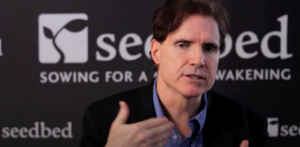 Our very wise guide told us, “Let the Bible be your tour guide.” With that wisdom, we made our pilgrimage through Israel, marking the sites in a Bible and listening as it told us the backstory of this rich and holy land.
Our very wise guide told us, “Let the Bible be your tour guide.” With that wisdom, we made our pilgrimage through Israel, marking the sites in a Bible and listening as it told us the backstory of this rich and holy land.
Israel for the pilgrim is not a vacation. It is an education. Tour buses are on the road by 7a, and don’t usually return until dinnertime. Days are filled with stop after stop at site after site where Bible stories actually (or more often, likely) happened. Not everything is certain. I’ve now visited both places where Jesus was buried. Some things, you just have to take with a grain of salt.
Meanwhile, other encounters were more moving than I expected. Just driving into Jerusalem had me close to tears. Seeing the replica of the scroll of Isaiah found at Qumran (not the real one, but the cast of it), was a spiritual encounter. Catching a glimpse from the bus window of the cave where the scrolls were found was surprisingly moving. I imagine everyone who goes has their moments.
Along with too many overpriced meals and souvenirs, I bring home a thousand insights, these among them:
God is a poet. Israel reveals just how intricately layered and beautiful the story of God is. He is not a mechanic who simply made a thing that works. Our Father is an artist and a brilliant story-teller. In Israel, things stack up on top of things and make connections I didn’t realize existed. For instance, it is stunning to stand in the place where Joshua and the people of Israel first crossed over the Jordan into their promised land, and to realize that Jesus was likely baptized in that same region (maybe even the same spot?) of the river. Two stories — about fifteen hundred years apart — in which the future of God’s people was decisively changed happened in the same place. It is revelatory to see that while the Jews walked across into the land of Jordan, Jesus came up out of the water and turned back toward the Mount of Temptation, back toward the land the Israelites chose the first time they missed their moment of promise. Seeing the geography, one can only wonder how faithless they had to be to make that choice.
Did you know that on Mt. Zion (God’s “hill of holiness” is a remarkably small piece of property) David’s death is marked in the same area where Jesus hosted the Last Supper? The tourist site has them in the same building. And we can make a case for Pentecost and the appearance of the resurrected Jesus to Thomas at the same site. It is all just next to Caiaphas’ house where Jesus was first accused and where he was likely held in an underground cell. The first church council of Jerusalem also happened on Mt. Zion, as did (tradition holds) Mary’s death. The top of one small hill binds together all these stories of birth and death, and the layers aren’t just geographical. The Talmud places David’s birth and death on the same date on the calendar (though a millennium apart) as Pentecost. What poetry.
These connections remind me of our Creator’s immense capacity for design. I’m also more convinced that there are far fewer coincidences in the world and far more poetic nuances than I notice. I hear the Elisha’s prayer for Gehazi: “Open his eyes, Lord, so that he may see.”
I’m a faker. On my way to Israel, I had a dozen or more people tell me, “You’ll never read the Bible the same again.” I hoped they were right but had no clue what they meant. I suspect I went there sort of like a parent going to the hospital to have a first  child. I thought I knew my Bible pretty well going into our pilgrimage but I had no clue. I may have a grasp of theology, but I am profoundly aware on this side of our trip just how many gaps need filling. I lack the broad historical framework that strings the biblical stories together and provides the real glue between Old and New Testaments. I am also aware of how much richer the story is when one understands the geography. To have in my head the size of the Sea of Galilee, the view from the Mount of Olives, the slope from the pool of Siloam to the temple, the landscape of what the Bible calls wilderness (the opposite of an American wilderness) — those images transform my understanding of the biblical stories. Israel makes me hungry for the bigger picture; I’m also humbled by how much more there is to learn.
child. I thought I knew my Bible pretty well going into our pilgrimage but I had no clue. I may have a grasp of theology, but I am profoundly aware on this side of our trip just how many gaps need filling. I lack the broad historical framework that strings the biblical stories together and provides the real glue between Old and New Testaments. I am also aware of how much richer the story is when one understands the geography. To have in my head the size of the Sea of Galilee, the view from the Mount of Olives, the slope from the pool of Siloam to the temple, the landscape of what the Bible calls wilderness (the opposite of an American wilderness) — those images transform my understanding of the biblical stories. Israel makes me hungry for the bigger picture; I’m also humbled by how much more there is to learn.
Community is essential. This lesson wasn’t learned so much from the biblical sites as from Israel’s — and more specifically Jerusalem’s — current climate. That this nation exists at all is nothing short of a miracle. In the midst of daily tensions and — all too often — life-threatening conflicts, the citizens of Jerusalem manage to make life work in the city, sometimes more tolerant of  one another than within their own groups. Note the current conflict among Jews about the Western Wall. Or how Christians manage their holy sites. The Church of the Holy Sepulcher is cohabited by five Christian groups — Greek Orthodox, Roman Catholic, Arminian, Coptic and Ethiopian. These groups live under the same roof but hold separate worship services and even separate Easter celebrations on separate days, not as a matter of respect but as a matter of avoidance. Their internal relationships are so fraught with conflict that they can’t trust one another even to hold the key to the building. Two Muslim families keep the key to this holiest of Christian sites, unlocking the door early every morning. While coexistence happens in Jerusalem, community is much more complicated.
one another than within their own groups. Note the current conflict among Jews about the Western Wall. Or how Christians manage their holy sites. The Church of the Holy Sepulcher is cohabited by five Christian groups — Greek Orthodox, Roman Catholic, Arminian, Coptic and Ethiopian. These groups live under the same roof but hold separate worship services and even separate Easter celebrations on separate days, not as a matter of respect but as a matter of avoidance. Their internal relationships are so fraught with conflict that they can’t trust one another even to hold the key to the building. Two Muslim families keep the key to this holiest of Christian sites, unlocking the door early every morning. While coexistence happens in Jerusalem, community is much more complicated.
And more rare. Jewish tradition holds that the Messiah will enter Jerusalem through the Old City’s Eastern Gates,  but to thwart the fulfillment of that prophesy, Muslims long ago bricked up the gates and turned the road just beyond into a cemetery (an “unclean” obstacle) to block the Messiah’s entry. In other words, coexistence is an ideal often mentioned in Jerusalem but coexistence isn’t the same as community. Yet, the biblical ideal is community. It is essential for healing and for the transformation of hearts. It is a recurring theme among the prophets.
but to thwart the fulfillment of that prophesy, Muslims long ago bricked up the gates and turned the road just beyond into a cemetery (an “unclean” obstacle) to block the Messiah’s entry. In other words, coexistence is an ideal often mentioned in Jerusalem but coexistence isn’t the same as community. Yet, the biblical ideal is community. It is essential for healing and for the transformation of hearts. It is a recurring theme among the prophets.
Many groups are calling for the building of the third temple in Jerusalem with the hope that this will hasten the next coming of the Messiah. My admittedly uneducated suspicion is that the temple with power to draw the Messiah in is not a building but a people with a peculiar kind of heart. Paul prophesied as much when he wrote to the Ephesians (2:19-22): “You are no longer foreigners and strangers, but fellow citizens with God’s people and also members of the household, built on the foundation of the apostles and prophets, with Christ Jesus himself as the chief cornerstone. In him the whole building is joined together and rises to become a holy temple in the Lord. And in him you are being built together to become a dwelling in which God lives by his Spirit.”
This is the trajectory of the biblical story and the hope of this holy land. It is the excavation and renovation of hearts by the Prince of Peace. And so today, I am more committed on this side of our pilgrimage to do as the psalmist instructs:
Pray for the peace of Jerusalem:
“May those who love you be secure.
May there be peace within your walls
and security within your citadels.”
For the sake of my family and friends,
I will say, “Peace be within you.”
For the sake of the house of the Lord our God,
I will seek your prosperity.









